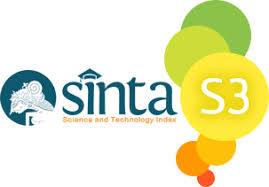Motives and Communication Style from Begalan Performers at Banyumas Area
 Abstract views: 364
,
Abstract views: 364
,
 PDF downloads: 162
PDF downloads: 162
Abstract
The presence of Begalan in wedding traditions is heavily reliant on the communication style of Begalan performers in introducing and preserving Banyumasan culture and language. The purpose of this research was to analyse and comprehend the motivations and communication styles of Begalan performers in the wedding tradition in the Panginyongan area of Banyumas. The qualitative descriptive research method is used in this study. Data collection entails observing, interviewing Begalan performers, and researching relevant literature. According to the findings of this study, 1) the motives of the Begalan performers in carrying out the wedding tradition in the Panginyongan area are ritual, entertainment, and professional motives; and 2) the communication style of the Begalan performers in the wedding tradition in the Panginyongan area of Banyumas tends to use a low context communication style. Another finding in this study is that there are obstacles experienced by Begalan performers, including diverse audiences with different cultures, lack of attention and appreciation from the audience, and lack of availability of the tools used in carrying out the Begalan procession. To overcome these obstacles, Begalan performers innovate using Indonesian and Banyumasan languages, adding to the audience's appeal by making jokes and preparing to get Begalan tools.
References
Cangara, H. (2018). Pengantar ilmu komunikasi. Depok: Raja Grafindo Persada.
Fajrie, M. (2018). Gaya komunikasi masyarakat pesisir Wedung Jawa Tengah. INJECT (Interdisciplinary Journal of Communication), 2(1), 53-76.
Gasing, S., dan Suryanto. (2016). Public relations. Yogyakarta: Andi Offset.
Herususanto, B. (2008). Banyumas: sejarah, budaya, bahasa, dan watak. Yogyakarta: LKiS Yogyakarta.
Huda, M. (2018). Kompetensi kepribadian guru dan motivasi belajar siswa (studi korelasi pada mata pelajaran PAI). Jurnal Penelitian, 1(2), 237-266.
Kholifah, A. N. (2018). Rendering cultural elements in banyumasan begalan. Jurnal Ilmiah Lingua Idea, 9(2), 81-90.
Kriyantono, R. (2006). Teknik praktis riset komunikasi. Jakarta: Kencana Pernada.
Kurniawan, A., Widodo, S., dan Saddhono, K. (2019). Happiness value inside traditional ceremony of begalan: research on communication activities ritual wedding. In 2nd Workshop on Language, Literature and Society for Education. Dipresentasikan di Solo pada tanggal 21 Desember 2018.
Mulyana, D. (2016). Ilmu komunikasi : suatu pengantar. Bandung: Remaja Rosdakarya.
Mulyana, D. (2020). Metodologi penelitian kualitatif. Bandung: Remaja Rosdakarya.
Priyanto, W. P. (2008). Nilai-nilai pendidikan dalam seni tutur begalan di Banyumas. Cakrawala Pendidikan, 27(2), 164-174.
Ruslan, R. (2017). Manajemen public relations dan media komunikasi: konsepsi dan aplikasi. Depok: PT. Raja Grafindo Persada.
Sugiyono. (2014). Metode penelitian kuantitatif, kualitatif, r&d. Bandung: Penerbit Alfabeta.
Suheri. (2019). Akomodasi komunikasi. Jurnal Network Media, 2(1), 40-48.
Sumampouw, C., Himpong, M., dan Tulung, L. (2016). Strategi public relations dalam mempromosikan Swiss-Bel hotel Maleosan Manado. E-Journal Acta Diurna, 5(1), 1-11.
Turistiati, A. T., dan Andhita, P. R. (2021). Komunikasi antarbudaya : panduan komunikasi efektif antar manusia berbeda budaya. Purwokerto: Zahira Media Publisher.
Virdaus, D. R. (2019). Gaya komunikasi dalam berita televisi (produksi pesan pada program berita pojok kampung jtv dan penerimaan pesan di kalangan masyarakat Jawa Timur). Mediakita, 3(2), 163-178.
Wahyu, E. A. A., dan Brata, N. T. 2020. Redefinisi makna tradisi begalan oleh Sanggar Sekar Kantil dalam ritus pernikahan masyarakat Banyumas. Budaya Etnika, 4(2), 86-97.
West, R., dan Turner, L. H. (2017). Pengantar teori komunikasi analisis dan aplikasi. Jakarta: Salemba Humanika.
Copyright (c) 2024 Jurnal Komunikasi Profesional

This work is licensed under a Creative Commons Attribution-ShareAlike 4.0 International License.

Jurnal Komunikasi Profesional is licensed under a Creative Commons Attribution-ShareAlike 4.0 International License.
1. Proposed Policy for Journals That Offer Open Access
Authors who publish with this journal agree to the following terms:
- Authors retain copyright and grant the journal right of first publication with the work simultaneously licensed under a Creative Commons Attribution License that allows others to share the work with an acknowledgment of the work's authorship and initial publication in this journal.
- Authors are able to enter into separate, additional contractual arrangements for the non-exclusive distribution of the journal's published version of the work (e.g., post it to an institutional repository or publish it in a book), with an acknowledgement of its initial publication in this journal.
- Authors are permitted and encouraged to post their work online (e.g., in institutional repositories or on their website) prior to and during the submission process, as it can lead to productive exchanges, as well as earlier and greater citation of published work (See The Effect of Open Access).
2. Proposed Policy for Journals That Offer Delayed Open Access
Authors who publish with this journal agree to the following terms:
- Authors retain copyright and grant the journal right of first publication, with the work [SPECIFY PERIOD OF TIME] after publication simultaneously licensed under a Creative Commons Attribution License that allows others to share the work with an acknowledgement of the work's authorship and initial publication in this journal.
- Authors are able to enter into separate, additional contractual arrangements for the non-exclusive distribution of the journal's published version of the work (e.g., post it to an institutional repository or publish it in a book), with an acknowledgement of its initial publication in this journal.
- Authors are permitted and encouraged to post their work online (e.g., in institutional repositories or on their website) prior to and during the submission process, as it can lead to productive exchanges, as well as earlier and greater citation of published work (See The Effect of Open Access).



